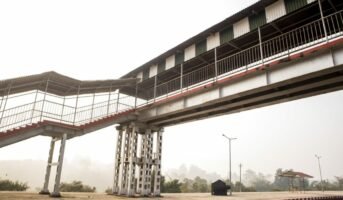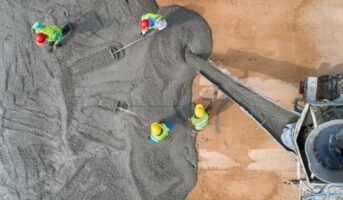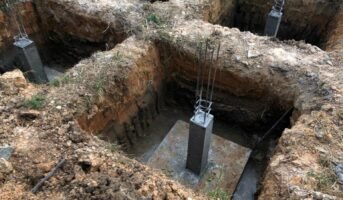The cable-stayed bridges are composed of a central tower and a deck supported by cables radiating from the tower to the deck. This design allows for longer spans and reduces the number of materials needed compared to traditional suspension bridges.
The cable-stayed concept is versatile and can be adapted for different types of terrain, such as over water or steep valleys. In a cable-stayed bridge, the cables provide stability, while the central tower adds strength to the bridge’s structure. This makes the cable stayed bridges ideal for various infrastructure projects, including high-traffic highways, railway lines, and pedestrian walkways. Notable examples of the cable-stayed bridges include the Millau Viaduct in France, the Sutong Yangtze River Bridge in China, and the San Francisco-Oakland Bay Bridge in the United States.
Cable-stayed bridge: Characteristics
The following features characterise the cable-stayed bridges:
- Design: The cable-stayed bridges have a unique design that consists of a tall tower and a deck supported by cables attached directly to the tower.
- Cable system: The bridge deck is supported by several cables, each connected at one end to the tower and the other end to the deck. The cable system provides the primary structural support for the bridge.
- Tall towers: The cable-stayed bridges are characterised by tall towers that support the cables and transfer loads from the deck to the foundations.
- Long spans: The cable-stayed bridges can span long distances, making them ideal for crossing extensive waterways or valleys.
- Load distribution: The cable system distributes the load evenly between the tower and the deck, reducing the stress on each component.
- Versatility: The cable-stayed bridges can be designed in various shapes and configurations to suit the specific needs of each project.
- Aesthetic appeal: The towers and cables of the cable-stayed bridges often create an aesthetically pleasing structure.
Cable-stayed bridge: Materials used
The cable-stayed bridges can be constructed using various materials, including:
- Concrete: This is the most common material used to construct the cable-stayed bridges.
- Steel: Steel is often used in combination with concrete to increase the strength and stability of the cable-stayed bridge.
- Composite materials: Composite materials such as fibre-reinforced polymers (FRP) can also be used to construct the cable-stayed bridges. These materials offer advantages such as high strength-to-weight ratios and resistance to corrosion.
- Prestressed concrete: This type of concrete is used to increase the strength and stability of the cable-stayed bridge by applying tension to the concrete before it sets.
The choice of materials will depend on factors such as the cable-stayed bridge’s design, the local environment, and the expected loads the bridge will have to withstand.
Cable-stayed bridge: Types
There are 3 main types of cable-stayed bridges:
-
Mono cable-stayed bridge

Source: Pinterest
A mono cable-stayed bridge is a type of bridge that has a single cable that is tensioned between the central tower and the deck. This type of cable-stayed bridge is typically used for smaller spans, such as pedestrian bridges, and is known for its simple design and low cost. An example of a mono cable-stayed bridge is the Liberty Bridge, Budapest.
-
Harp cable-stayed bridge

Source: Pinterest
A harp cable-stayed bridge is a type of bridge that has cables that are arranged in a harp-like pattern from the central tower to the deck. This type of cable-stayed bridge is often used for medium-span bridges and is known for its elegant appearance. An example of a harp cable-stayed bridge is the Tacoma Narrows Bridge in Washington.
-
Fan cable-stayed bridge

Source: Pinterest
A fan cable-stayed bridge is a type of bridge that has cables that are arranged in a fan-like pattern from the central tower to the deck. This cable-stayed bridge is typically used for longer spans and is known for its stability and strength. An example of a fan cable-stayed bridge is the Russky Bridge in Vladivostok, Russia, one of the world’s most extended cable-stayed bridges.
In all types of cable-stayed bridges, the cables provide stability to the bridge and transfer the weight of the deck to the towers. The towers resist the tension in the cables and transfer the loads to the foundation. The height of the towers and the number and arrangement of cables can be designed to meet the specific requirements of each project.
Cable-stayed bridge: Design and construction
Cable-stayed bridges are suspension bridges that utilise cables attached directly from the bridge deck to one or more towers. They are characterised by a distinctive “V” or “fan” pattern of cables radiating from the tower to the deck.
The design and construction of a cable-stayed bridge involve several key steps:
- Feasibility analysis: The first step is to determine the feasibility of the bridge by analysing factors such as bridge length, traffic volume, and cost.
- Design: A structural engineer designs the bridge’s deck, towers, and cables based on load and stress calculations, considering the site’s wind and seismic conditions and selecting materials that meet the design requirements.
- Foundation work: The next step is to construct the foundation for the towers and anchors. It typically involves deep excavation, pile driving or drilling, and concrete placement.
- Tower erection: The towers are typically constructed using steel or concrete and are erected using cranes or other heavy equipment.
- Deck construction: The deck is constructed in sections and supported by temporary structures until the cables are installed.
- Cable installation: The cables are typically high-strength steel attached to the deck and the tower. The cables are tensioned to support the deck and provide stability.
- Final testing: Before the bridge is opened to traffic, final tests are conducted to verify its structural integrity and safety.
The construction of cable-stayed bridges requires specialised expertise and heavy equipment and is a complex and challenging process. However, the resulting bridge can be aesthetically pleasing and highly efficient, making it a popular choice for many bridge projects.
Cable-stayed bridge: Advantages
- Efficient use of materials: The cable-stayed bridges are lighter than other bridges, making them cost-effective.
- Aesthetics: The cable-stayed bridges can appear attractive, especially when the cables are arranged in a fan-like configuration.
- High strength-weight ratio: The cables provide additional strength, making the bridge sturdy and able to withstand high wind and seismic loads.
- Better stability: The cables provide a more balanced distribution of forces, resulting in a more stable structure.
- Cost-effective for medium-span bridges: The cable-stayed bridges are suitable for medium-span bridges, which can be more economical than other types of bridges.
Cable-stayed bridge: Disadvantages
- Maintenance costs: The cable-stayed bridges require regular maintenance and replacement of cables, which can be expensive.
- Complex construction: The cable-stayed bridges are complex to construct, requiring specialised equipment and skilled labour.
- High initial cost: The initial cost of building a cable-stayed bridge is often higher than other bridges.
- Limited span: The cable-stayed bridges are only suitable for a short span, as their height becomes unmanageable and their weight increases.
- Vulnerability to cable snapping: In the case of cable snapping, the whole bridge structure can collapse, making cable-stayed bridges potentially dangerous.
FAQs
What is a cable-stayed bridge?
A cable-stayed bridge is a suspension bridge that features cables extending from towers to the bridge's deck. These cables provide the necessary support to the bridge and help distribute weight evenly across the bridge structure.
How does a cable-stayed bridge work?
The weight of the bridge deck is carried by the cables attached to the towers on either side of the bridge. The towers are responsible for supporting the weight of the bridge deck and the cables. The cables also stabilise the bridge and prevent it from swaying in strong winds or earthquakes.
What materials are used to construct cable-stayed bridges?
The materials used to construct cable-stayed bridges include steel, concrete, and cable wire. The steel is used for the towers, while the concrete is used for the bridge's deck. The cable wire is used for the cables that support the bridge.
How long do cable-stayed bridges last?
The lifespan of a cable-stayed bridge depends on several factors, including the materials used, the design, and the level of maintenance. Generally, cable-stayed bridges have a lifespan of around 50 to 100 years, although they can last longer with proper maintenance.
Are cable-stayed bridges safe?
Cable-stayed bridges are considered safe but are also subject to the same risks as other types of bridges, such as wind, earthquakes, and corrosion. Regular maintenance and inspections are necessary to ensure the safety of cable-stayed bridges.
Got any questions or point of view on our article? We would love to hear from you. Write to our Editor-in-Chief Jhumur Ghosh at [email protected]
Housing News Desk is the news desk of leading online real estate portal, Housing.com. Housing News Desk focuses on a variety of topics such as real estate laws, taxes, current news, property trends, home loans, rentals, décor, green homes, home improvement, etc. The main objective of the news desk, is to cover the real estate sector from the perspective of providing information that is useful to the end-user.
Facebook: https://www.facebook.com/housing.com/
Twitter: https://twitter.com/Housing
Email: [email protected]











